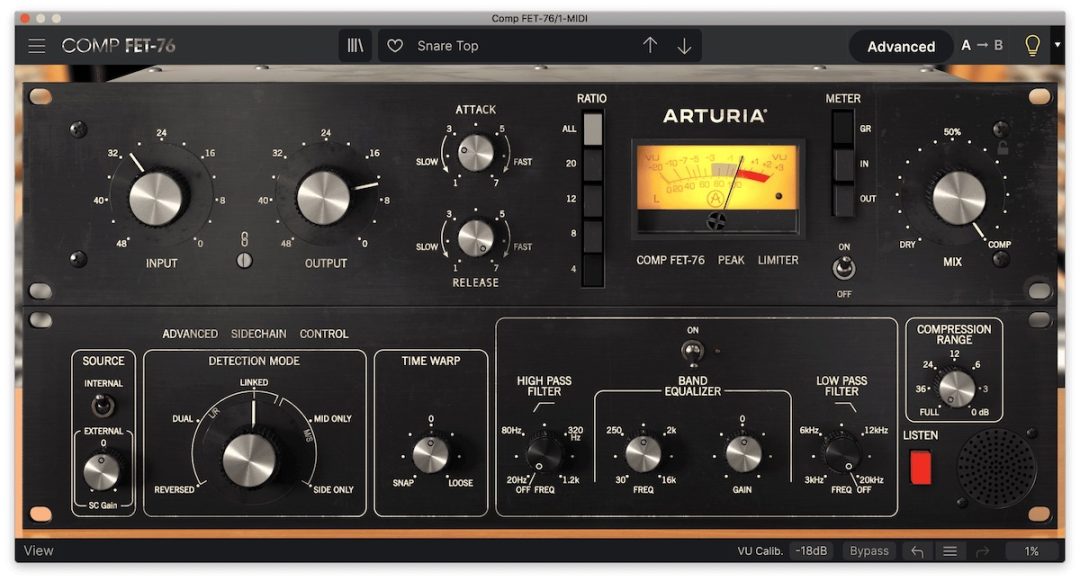Founded in 1999, Arturia began their journey in music-making software. Fast forward to the present, and they’re a celebrated producer of analog-emulated classic keyboards and synthesizers, effects, and hardware of their own. Today, we’re diving into a review of the Arturia FET 76 compressor — an emulation of one of the most famous processors of all time.
What Is FET Compression?
FET stands for field-effect transistor. These kind of transistors use an electrical field to control the flow of current in a semiconductor. In “music gear” terms, FET compression became a solid-state alternative to vacuum tube compression. Tube compressors like the Fairchild were the go-to tools of the day, but the introduction of FET compression gave engineers a brand new flavor to add to their recordings. Generally speaking, FET compressors have an incredibly fast response time compared to tubes, so they can emphasize transients for a more aggressive compression style. And none other is more famous than the 1176.
A Brief History of the UREI 1176
Bill Butnam (legendary founder of Universal Audio) developed the United Recording Electronics Industries (UREI) 1176 FET compressor between 1966-67. The first models debuted in ’67 as revisions A and AB with silver faceplates and a blue-striped meter section. In 1970, Putnam refined the design to be less noisy and with less distortion. Revision C, as it was called, introduced the black faceplate and was re-dubbed the 1176LN — the most famous version of the timeless processor.
The compressor underwent numerous revisions over the years until Putnam sold UREI in 1985. Putnam’s sons re-established the Universal Audio brand in 1999 and re-issued the iconic 1176LN in 2000. Easily one of the most-used compressors ever, there have been countless software emulations of it over the years. Well known iterations include those by (obviously) UAD, Waves, Slate, Avid, and others. A few years ago, Arturia debuted the FET 76 as their own unique take on a classic.
Arturia FET 76 Review: What Makes It Special?
For anyone not familiar with the 1176, you’re looking at a fairly straightforward compressor. It uses a fixed threshold where the amount of gain reduction is adjusted by the input control, and subsequently the output controls the overall level after compression. You have continuously variable attack and release settings — 20 to 800 microsecond attack and 50 ms to 1.1 second release. Finally you have selectable ratios and the infamous “all buttons in” setting for extremely aggressive compression that’s great for parallel effects.
- RELATED: The 15 Best Compressor Plugin VSTs
Many times with software, we want modern convenience included — not just a “faithful” recreation of an analog classic. We want the classic sound, of course, but the point of software is to make our lives a bit easier. The FET 76 by Arturia adds a mix knob to the far right of the panel to easily blend wet/dry for parallel compression.
Major differences are found in the drop-down panel of the FET 76. Here you’ll find unique features like Time Warp, which adds pre-delay to the signal so you can more creatively place the compression envelope as it begins and releases. There’s also a handy filter section and adjustable single-band EQ to further manipulate the sound (as part of the advanced sidechain control). With this panel alone, the Arturia FET 76 contains many more features than the average 1176 emulation.
Perfect Your Vocals
The 1176 features on vocals all the time. It’s just an amazing way to handle the dynamic intricacies of the voice, with the energy it imparts on a performance second to none. Especially for aggressive vocals like rap or metal, the 1176 adds a ton of character that suits the genres well.
- RELATED: Vocal Compression for Beginners
Many engineers reach for a 76 as their “first line of defense” to catch the sharpest peaks. The FET 76 holds true for this purpose.
Sidechain Panel
Arturia’s inclusion of the advanced sidechain panel is one of the elements that sets the FET 76 apart from other plugins. It offers modern sidechain controls with an SSL-style EQ section. The possibilities are pretty wild, and it would certainly be wise to experiment to see what tonal variations are out there.
- RELATED: Sidechain Compression Explained
Tone & Saturation
Like the OG hardware, the FET 76 imparts a wholly unique sonic character on any signal. The sound is often described as bright, present, and energetic. Despite being a dynamics processor, many people note the wonderful equalization characteristics it appears to impress on the signal. Some engineers go so far as to leave compression off and just run a signal through the circuitry for the tone alone. The FET 76 does an excellent job of capturing that magic. From subtle leveling to saturated parallel compression, the FET 76 is a versatile tool.
Our Take: The Arturia FET 76 Offers a New Flavor of Time-Tested Compression
Arturia’s take on the 1176 is surely worth having a go. They’ve done an admirable job of replicating the timeless sound of a certified studio classic while still making it their own with a host of original, modern appointments. We’re also impressed with the price of the FET 76 that makes it accessible to most. If you’re looking for your first or even your 10th FET compressor plugin, put Arturia on the list.
